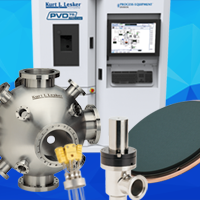Thermocouple Feedthroughs Technical Notes

Overview
Measuring Temperatures
Although well beyond the scope of these notes, it is important to realize that measuring temperatures with thermocouples in vacuum presents many underappreciated difficulties. For example, just resting a T/C's junction on a polished silicon wafer mounted close to a heater gives no indication of the silicon's temperature. The silicon is almost 100% transparent in the IR energy spectrum. The recorded temperature is related to the emissivities of T/C and heater materials, the heater's temperature, the T/C's temperature, and their mutual "shape factor."
Thermocouples (T/Cs) are two dissimilar metal wires that meet at a (welded) junction. The junction's temperature and the individual wire's composition determine the voltage difference (often called "EMF" for electromotive force) between the wires' ends. Ideally, each wire's composition is unchanged from junction to the measurement device nominally a voltmeter. That means the signals should be transferred through the vacuum wall by wires of identical composition too, and that is the function of a T/C feedthrough.
T/C feedthroughs can have one or multiple pairs of wires. The wires are air-side terminated to accept one of several connections methods: molded plugs, push-on split connectors, flat areas drilled for screw/nut, lugs for screw/nut, and screw connectors (for multi-pair feedthroughs).
Vacuum-side connections might be push-on split connectors, flat areas drilled for screw/nut, lugs for screw/nut, and screw connectors (for multi-pair feedthroughs).
T/C materials, governed by ANSI standards (and some non-standard materials), with suggested temperature ranges are shown in Table 1. But not all thermocouple materials are available in vacuum-feedthrough form.
In applications requiring precious metal T/Cs, the leads and feedthroughs of the same materials would be expensive. In practice, "compensating metal" wires are used from the ends of the true T/C wires, through the feedthrough, to the meter. NOTE: The temperature of the joint between true T/C wire and compensating wire must not exceed the value given in Table 1.
When selecting T/C feedthroughs, major considerations are the indicated temperature range, the number of temperature measurement locations, and the requirement of power conductors built into the same feedthrough.
Table 1: Thermocouple Feedthroughs
| ANSI Type | Thermocouple Material | Temperature Range (°C) |
Compensating Wire Junction |
|
| Positive | Negative | |||
| T | Copper | Constantan | -184 to 400 | N/A |
| K | Chromel™ | Alumel® | -184 to 1260 | N/A |
| J | Iron | Constantan | 0 to 750 | N/A |
| S | Platinum/10% Rhodium | Platinum | 0 to 1540 | 250° C |
| R | Platinum/13% Rhodium | Platinum | 0 to 1540 | 250° C |
| C | Tungsten/5% Rhenium | Tungsten/26% Rhenium | 0 to 2760 | 250° C |
| E | Chromel | Constantan | -184 to 900 | N/A |
| N | NI-CR-SI | NI-SI-MG | -270 to 1300 | N/A |



